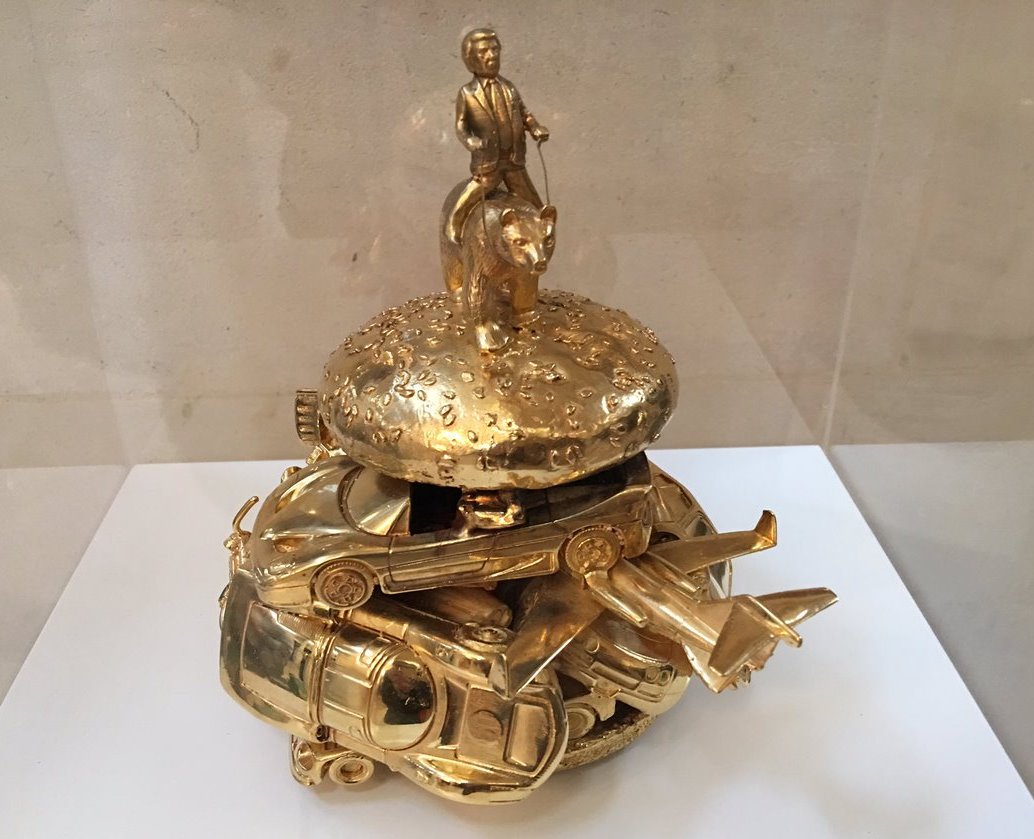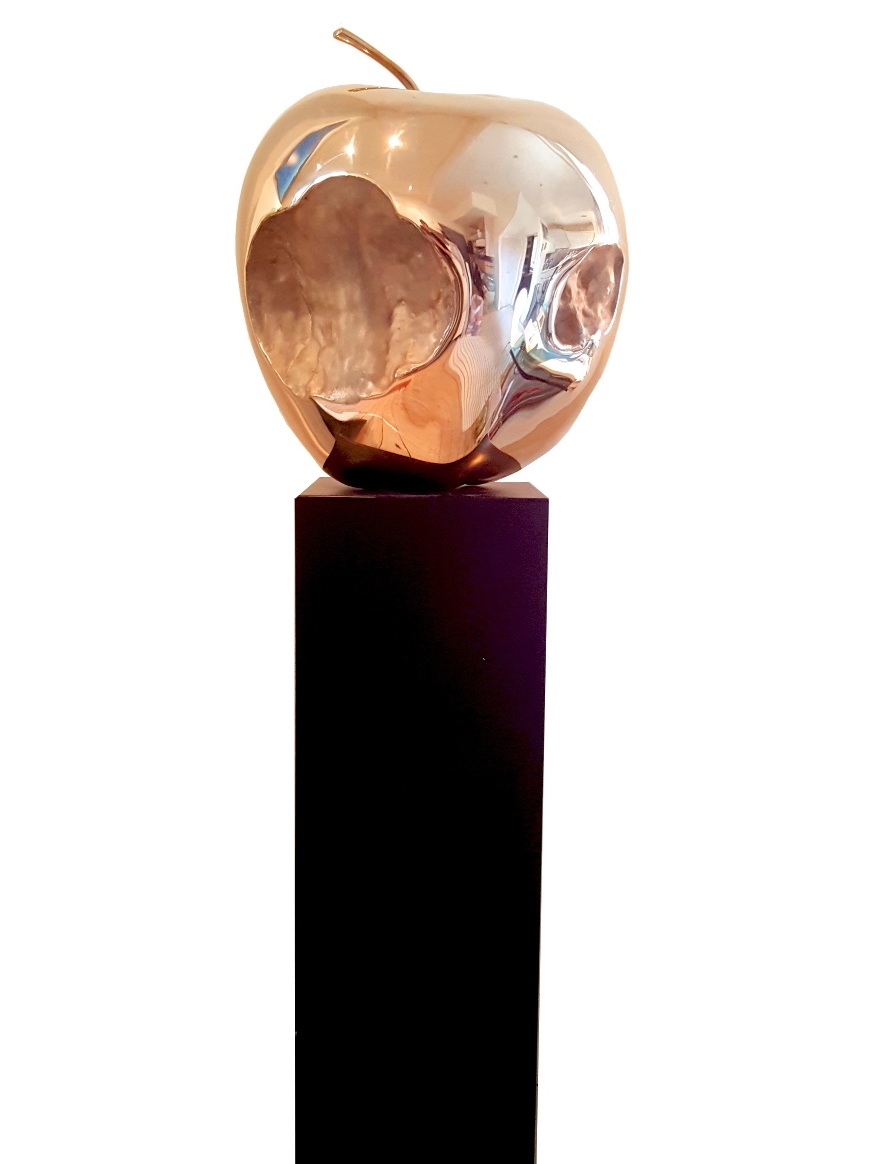Cadenet, Alexander de - VM - Jonathan Evens
Alexander de Cadenet: Trump Burger 2

Excessive Consumption
by Jonathan Evens
Alexander de Cadenet’s sculptures raise important questions regarding what and how much we consume.
His Life-Burger sculptures in particular explore the relationship between the spiritual dimension of art and consumerism and investigate what gives life meaning. Los Angeles art critic Peter Frank has stated that, "We're at a moment in modern history where the excess has gotten staggeringly wretched. Oligarchs worldwide shock us and shame themselves with their conspicuous consumption – a consumption that extends to the rest of us, as consumed no less than as consumers. Alexander de Cadenet encapsulates this emerging neo-feudal order in his gilded and multi-decked burgers. For the meta-rich, the world is their fast food joint, and their appetite insatiable."
De Cadenet has suggested that, “What’s problematic is the desire to consume and accumulate for the sake of it, often to run away from pain or discomfort. Beauty and pleasure can at some point become quite warped and grotesque without limits, where even the original value gets lost or diluted within excess. I think it’s become more and more prevalent in the world today and it’s very much part of the art world system too in the way that artworks are commoditized and their original beauty can get lost in the transformation into status symbols.”
Art historian Edward Lucie-Smith has perceptively noted a similar paradox, “The Life-Burgers,” he says, “offer a sharp critique of the society we live in and yet simultaneously they are luxury objects in their own right.”
De Cadenet has said that he grew up exposed to these values and that this has been valuable for him as a yardstick to compare things to, while also giving insights into its darker aspects. As a result he is a playful moralist, conscious of his own ambivalent relationship to ‘morality’, which means that “any ‘moralizing’ is not done with self-righteousness but more as a way to explore and express the inherent paradoxes and richness of life.”

We can see this at play in another key work, Creation, a large scale shiny bronze apple with three bites taken from it – two adult bites and baby bite in between. This clearly references the second Creation story in the Book of Genesis, where Eve is tempted by the serpent to eat the apple from the Tree of the Knowledge of Good and Evil, which Adam and Eve had been forbidden to eat. Adam also eats the apple (the second adult bite) but when challenged by God passes the buck to Eve, who then puts the blame on the serpent.
The Genesis Creation stories can be read as descriptions of key human tendencies such as our grasping after those things that we have been told we should not have, our willingness to cross boundaries to acquire them and our refusal to accept personal responsibility for our own actions when we are found out. There is a clear link between these characteristics and the consumerist desires that are satirized in the Life-Burgers. The biblical witness is that these desires characterise every generation. This may be why the baby bite appears in De Cadenet’s Creation as an indication of these tendencies arising in future generations as well as current ones.
De Cadenet asks how we can transcend original sin, the bite that we all take by being born? He says: “For some, the body of Christ is the vehicle to connect to that deeper dimension, for others it may be to meditate in nature or connect to an artwork that can act as a portal to the deeper dimension. For some creatives transcendence may be to create an outer manifestation of their deepest most sacred connection to life – to create new forms that offer the opportunity to others to expand consciousness and share the joy of their existence.”
His intention was for the apple sculpture to say something of the transformative power of art by using the Christian symbol of temptation, “In Genesis we were told by God not to take a bite from the apple, yet it was by taking a bite that we became ‘self-conscious’ and self-consciousness is what is necessary for making art.” By eating the fruit Adam and Eve gained knowledge of good and evil, which enables us to create, but which also means that our creativity can be used for good or for evil.
De Cadenet’s Creation is, therefore, a prayer offered for humanity’s deliverance from ignorance, ingrained materialism and the seemingly ever-increasing thirst for worldly power. His prayer could be that which Desmond Tutu adapted from Francis Drake: “Disturb us, O Lord, when with the abundance of things we possess, we have lost our thirst for the water of life.”
*******
Alexander de Cadenet: Trump Burger 2, 2017, solid silver with gold plating, 18 x 23 cm.
Alexander de Cadenet: Creation, 2015, bronze, edition of 20.
Alexander de Cadenet is a British artist working in photography, sculpture and painting. His work explores a range of philosophical and spiritual themes and is intended as a portal to access a deeper dimension of existence. He describes his work as, “An investigation into the parameters of awareness and consciousness.” He has set up the Awakened Artists platform to showcase specially invited artists whose work accesses a deeper spiritual dimension. A selection of de Cadenet’s projects and participations include Victoria & Albert Museum (1998), Museum of Modern Art Ostende (2001), Courtauld Institute of Art (2003), Beijing Olympics (2008), Museum of Torrance (2012), and St Stephen Walbrook, London (2017). https://www.alexanderdecadenet.com/
Jonathan Evens is Vicar for Partnership Development at St Martin-in-the-Fields, London, England. A keen blogger, he posts regularly on issues of faith and culture at www.joninbetween.blogspot.co.uk. His journalism and art criticism ranges from A.W.N. Pugin to U2 and has appeared in a range of publications, including Church Times. He runs a visual arts organisation called commission4mission, which encourages churches to commission contemporary art and, together with the artist Henry Shelton, has published two collections of meditations and images on Christ's Passion. Together with the musician Peter Banks, he has published a book on faith and music entitled The Secret Chord.
ArtWay Visual Meditation February 25, 2018


